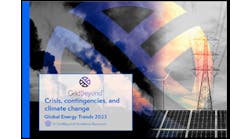During this summer’s heatwave in the US, multi-tasking microgrids kept the lights on in a small California community surrounded by wildfire, supported the Texas grid during power emergencies, islanded to relieve stress on the California power system and helped an Oregon military facility meet its air conditioning needs when temperatures soared.
In California and Oregon, utilities implemented widespread Public Safety Power Shutoff (PSPS) events during which they shut off power in order to prevent their electrical equipment from sparking fires during hot and windy weather. In Oregon, Portland General Electric (PGE) implemented its second PSPS event to date — following a smaller PSPS last year in the Mount Hood area —and it affected more than 37,000 homes and businesses located in over 10 PSPS areas, said PGE.
Reduced use of diesel
Deploying clean energy microgrids not only aided the grid and kept the lights on but also helped reduce the use of polluting stand-alone diesel generators.
During PSPS, utilities and customers have been using stand-alone diesel generators in areas experiencing outages, but utilities are trying to move away from fossil fuels. In the San Francisco Bay Area, the use of backup generators increased by 34% over the last three years in response to PSPS and outages, according to research from the consulting group M. Cubed. The backup generators equate to 15% of the state’s total electric capacity and 90% of them use carbon-intensive diesel fuel.
During the recent PSPS in Oregon, PGE deployed 25-KW stand-alone diesel generators to power mobile community resource centers that provided ice, Wi-Fi water and charging, said Andrea Platt, spokeswoman for PGE. “In the spirit of continual improvement, we’ll explore the options available for moving to emergency support resources that offer cleaner energy options as we plan for next year,” she said.
The mobile resource centers served about 2,500 individuals, families and community members.
In California, Pacific Gas & Electric (PG&E) ran about 40 MW of temporary diesel generation at three substations to support the grid during the week of September 5, said Paul Doherty, company spokesman.
To improve on its PSPS response, Pacific Gas & Electric (PG&E) has unveiled a device that makes it easier for homeowners to disconnect personal microgrids from the grid during outages and reconnect them automatically when utility power is available.
Military, home and business microgrids to the rescue
Over the summer — and especially during the heatwave in August — military, residential and commercial microgrids aided utility customers and the grid in California, Texas and Oregon, in many cases responding to calls for utilities for help.
On July 13, during an energy emergency in Texas, microgrids from provider Enchanted Rock produced nearly 2,000 MWh during an Emergency Response Service event called by the Electric Reliability Council of Texas. The power came from its numerous microgrids. During demand response events, Enchanted Rock produced 32,742,478 MWh of energy over 374.3 hours from June through August, said Allan Schurr, chief commercial officer, Enchanted Rock.
Enchanted Rock operates microgrids that produce more than 556 MW at more than 265 sites, and has more than 250 under construction across the U.S., said Schurr.
“Enchanted Rock customers utilized their dual-purpose microgrids to curtail their reliance on the grid during periods of high demand, helping keep the grid stable while avoiding high demand fees as well as transmission fees,” said Schurr.
Also active in responding to calls for help from utilities and system operators was the Marine Corps Air Station Miramar. Last year Miramar inked a deal with San Diego Gas & Electric (SDG&E) under which Miramar would provide generation from its microgrid to help avert emergencies.
Under that initial agreement, the total incentive to Miramar would not exceed $110,000 a month, which would represent payments for 6 MW five times a month. This year, the air station signed a similar agreement, and put it to good use.
On Aug. 17, in response to a statewide flex alert, the base operated islanded its microgrid from 4 pm to 9 p.m. The move — the first under the unusual agreement between SDG&E and Miramar — relieved some of the demand on the grid created by the base. A few weeks later, a number of Emergency Load Reduction Program (ELRP) events were issued, and the air station participated in all of them, said Mick Wasco, utilities & energy management director for the air station. Under the ELRP, utilities pay electricity consumers for reducing energy consumption or increasing electricity supply during periods of emergencies.
Tribal microgrid reduces grid stress
Blue Lake Rancheria also responded to calls for help, said Jana Ganion, sustainability and government affairs director for Blue Lake Rancheria, a federally recognized Native American tribal government.
The tribe’s microgrids islanded beginning on September 1 and continued islanding through September 9, each day from 4 pm to 9 pm to help ease stress on the grid, she said.
“Though the avoided load is relatively small, combined (about) 0.65 MW, it helped within this region where local substations were showing very high spot pricing indicating specific local points of stress,” she added.
In addition to responding to such alerts, microgrids were able to provide power to communities during fires. In July, during the Oak Fire, sparked in the foothills of the Sierra Nevada mountains, a remote, off-grid microgrid from BoxPower in Briceburg, California continued to operate. The microgrid is owned by PG&E.
“That region has no utility except for the remote grid. The microgrid functioned even with fire at its doorstep,” said Jenna Herzog, director of marketing and communications for BoxPower.
And in Oregon, a military microgrid at the Colonel Nesmith Readiness Center in the city of Dallas helped provide air conditioning for the center during the hottest days, said Stephen Bomar, director, public affairs, Oregon Military Department. The microgrid can provide power to the center and community members for up to 14 days during outages.
“We had fires in the general area and evacuations occurred in the surrounding community, but we survived very well with the microgrid.” — Eric McManus, Oregon Military Department
Without the microgrid, the readiness center would have had to rely on backup generation and utility power, he said.
Tyler Clayton, solutions manager for Ageto Energy — which provided the controls for the microgrid — said that during some of the most recent hot days, trend data showed higher than usual electrical loads at the facility. These higher loads were probably due to the need to cool the facility. On these hot days, the battery was fully discharged overnight to limit utility power consumption. Once the sun came up the next day, power from the solar PV arrays help limit utility power consumption as well as recharge the batteries.
Said Eric McManus, senior project manager at the Oregon Military Department, “We had fires in the general area and evacuations occurred in the surrounding community, but we survived very well with the microgrid.”
Also in Oregon, 200 homes were capable of keeping power running in public safety power shutoff (PSPS) zones thanks to residential solar microgrids funded in part by incentives from the Oregon Energy Trust, said Jeni Hall, advanced solar program manager for the organization. The incentives went specifically to residents located in areas that face high fire threats. The organization was not able to track which of the home microgrids kept the lights on in zones where power was shut off by the utility.
The ability of the microgrids to serve remote, fire-prone communities, help meet high air conditioning loads, keep power running in homes and provide critical services to the grid is a reminder of all that microgrids can do for utilities and their customers during emergencies.
The multi-tasking microgrids helped out customers and their electric providers and operated successfully surrounded by fires, with temperatures soaring beyond 100 degrees. “There were no negative impacts on the (Briceburg microgrid’s) performance, even with a wildfire only a few miles away,” said BoxPower’s Herzog.
Track news about the performance of microgrids during disasters. Subscribe to the free Microgrid Knowledge Newsletters.








